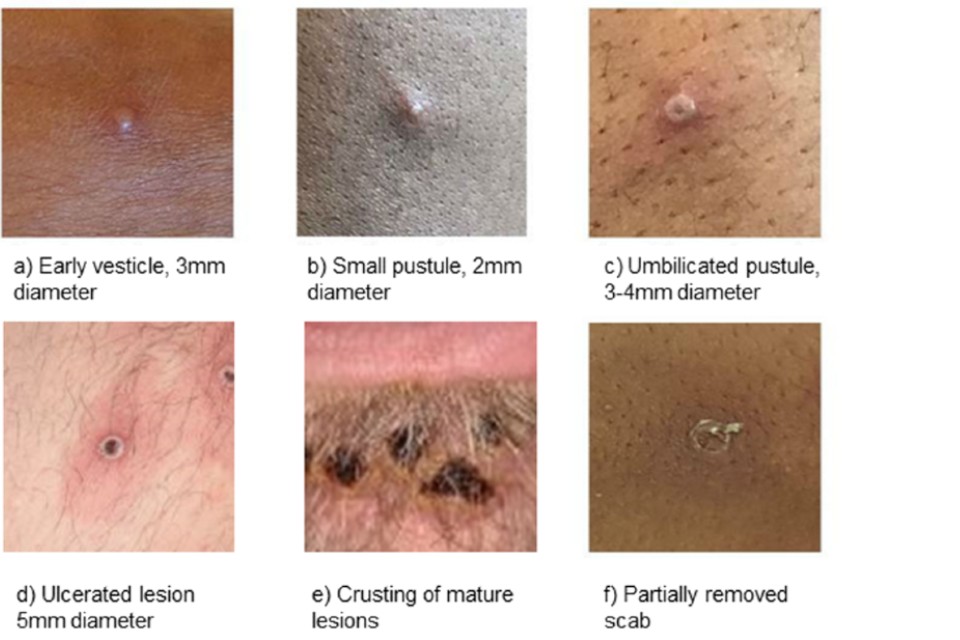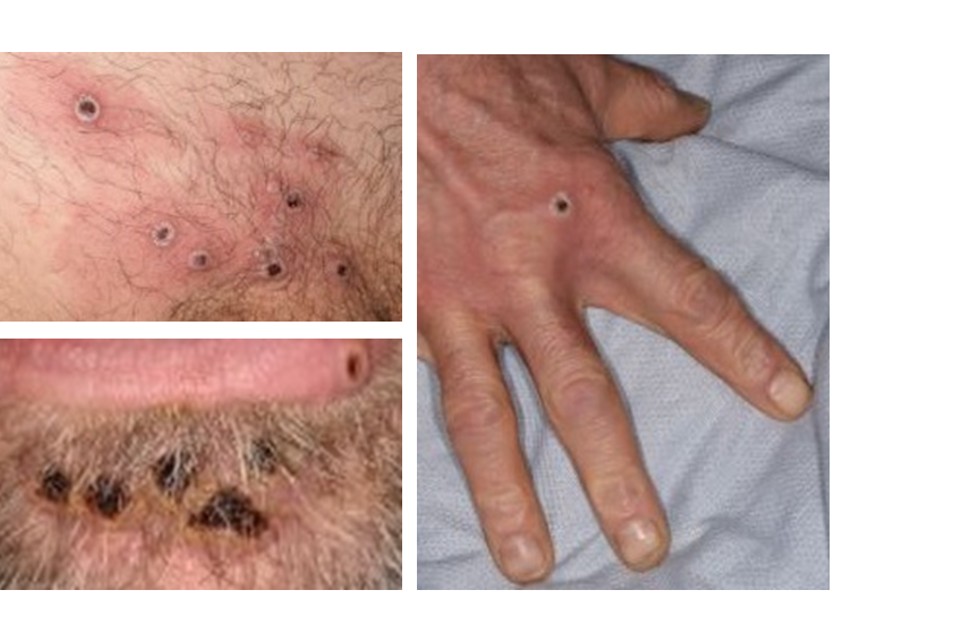Monkeypox:Mpox (monkeypox): background information
The epidemiology, symptoms, diagnosis and management of monkeypox virus infections.
Guidance
See the monkeypoxmpox collection page for further resources including guidance for health professionals.
Epidemiology
MonkeypoxMpox is a rare disease that is caused by infection with monkeypox virus.virus (MPXV).
MonkeypoxMpox was first discovered in 1958 when outbreaks of a pox-like disease occurred in monkeys kept for research. The first human case was recorded in 1970 in the Democratic Republic of the Congo (DRC), and since then the infection has been reported in a number of central and western African countries. Prior to 2022 most cases were reported from the DRC and Nigeria.
In 2003, monkeypoxmpox was recorded in the US when an outbreak occurred following the importation of rodents from Africa. Cases were reported in both humans and pet prairie dogs. All the human infections followed contact with an infected pet exposed to an imported animal and all patients recovered.
Since May 2022, cases of monkeypoxhuman mpox have been reported in multiple countries that dohave not usuallypreviously havehad monkeypoxMPXV virus in animal or human populations, including the UK.
There are 2 major genetic groups (clades) of MPXV, Clade I (formerly known as Central African or Congo basin clade) and Clade II (formerly known as West African clade). Clade II is split into Clade IIb and Clade IIa, with subgroup clusters called lineages. The majority of the cases seen in the outbreak in 2022 were from Clade IIb, lineage B.1.
Since January 2023, Clade II mpox is no longer considered a high consequence infectious disease (HCID) within the UK. Clade I mpox remains an HCID. There is further information on the HCID status of mpox available.
2022
ContactAs tracingof and31 investigationsMay are2023, ongoingover to3,700 identifycases whereof andmpox howhave thebeen casesidentified reportedin the UK since 7 May acquired2022. theirThe infection.
2021
Inmajority Mayof 2021these andcases Junehave 2021,been 3from monkeypoxthe casesClade wereII reportedB.1 fromlineage withinand thehave sameoccurred family;in thegay, indexbisexual, caseand hadother recentmen travelwho have sex with men (GBMSM) without documented history of travel to Nigeria.
2019
Inendemic Decembercountries. 2019,Further aninformation individualon inthe Englandepidemiology wasof confirmedthese tocases haveis monkeypoxavailable afterin recentlythe travellingmpox fromepidemiological Nigeriaoverview toand the UK.mpox technical briefings.
2018
InDuring September2022, 2018,a 2small casesnumber of monkeypoxnon-B.1 werecases have also been identified infollowing individualsrecent whotravel.
Between had2018 recentlyand travelled2021, fromthere Nigeriawere to7 cases of mpox in the UK. TheOf casesthese, 4 were epidemiologicallyimported unconnected.
Aand third2 monkeypoxwere casecases was reported in Septemberhousehold 2018.contacts. TheOne case was a healthcare worker involved in the care of one of thethese previous cases in 2018 and was infected following contact with contaminated bed linen.
Travel relatedThis monkeypoxis casesthe haveonly alsodocumented beenhealthcare reportedworker inacquisition, and the USrisk into 2021,healthcare Singaporeworkers inis 2019,extremely Israellow. inThere 2018was andno Benindocumented community transmission in 1978.these outbreaks.
Transmission
MonkeypoxMpox does not spread easily between people.people unless there is very close contact.
Spread of monkeypoxmpox may occur when a person comes into close contact with an infected animal (rodents are believed to be the primary animal reservoir for transmission to humans), human, or materials contaminated with the virus. MonkeypoxMpox has not been detected in animals in the UK.
The virus entersis thetransmitted body through brokenskin-to-skin skincontact, (evenbreathing ifin notvirus visible),through the respiratory tract, or thecontact with mucous membranes (eyes, nose, ormouth, mouth).genitals).
Person-to-person spread may occur through:
- direct contact with
monkeypoxholdingotherhands)skin-to-skin contact) - coughing or sneezing of
ansomeoneindividualwhowithhasampoxmonkeypoxrash - contact with clothing or linens (such as bedding or towels) used by
ansomeoneinfectedwithpersonmpox
Clinical features
The incubation period is the duration/time between contact with the infected person with mpox and the time that the first symptoms appear. The incubation period for monkeypoxmpox is between 5 and 21 days.
MonkeypoxMpox infection is usually a self-limiting illness and most people recover within several weeks. However, severe illness can occur in some individuals.
The illness begins with:
- fever
- headache
- muscle aches
- backache
- swollen lymph nodes
- chills
- exhaustion
- joint pain
However, not all people who have mpox experience all of these symptoms. Within 1 to 5 days after the appearance of fever, a rash develops, often beginning on the face then spreading to other parts of the body.body Thisincluding the soles of the feet and palms of the hands. Lesions can includealso affect the mouth, genitals and anus. The rash changes and goes through different stages before finally forming ascabs scab which latereventually fallsfall off.
Some individuals may not have a widespread rash, and in some cases only genital lesions are present. These may be blisters/vesicles, scabs or ulcers.
An individual is contagious until all the scabs have fallen off and there is intact skin underneath. The scabs may also contain infectious virus material.
Images of individual monkeypoxmpox lesions


Notes
Areas of erythema and/or skin hyperpigmentation are often seen around discrete lesions.
Lesions can vary in size and may be larger than those shown.
Lesions of different appearances and stages may be seen at the same point in time.
Detached scabs may be considerably smaller than the original lesion.
Diagnosis
Clinical diagnosis of monkeypoxmpox can be difficult, and it is often confused with other infections such as chickenpox. A definite diagnosis of monkeypoxmpox requires assessment by a health professional and specific testing in a specialist laboratory.
In the UK, testing is provided by many NHS laboratories, and is also available at the Rare and imported pathogens laboratory (RIPL) at the UK Health Security Agency (UKHSA) Porton DownDown.
Patients provideswith a monkeypoxtravel diagnosticor laboratoryexposure testinghistory serviceindicating althoughpossible someClade locationsI may(HCID) havempox localshould testingbe arrangementsdiscussed inwith place.
Samplesthe fromRIPL suspectedclinical andteam confirmedas casessoon ofas thepossible currentvia 2022the outbreak24/7 shouldImported beFever shippedService ashelpline Category(0844 B778 diagnostic8990).
Samples samples,from whilesuspected thoseand from confirmed cases which are not part of thempox 2022 outbreak should be shipped as Category A.B diagnostic samples. See guidance on diagnostic testing for information on how to submit samples for testing.
Treatment
Treatment for monkeypoxmpox is mainly supportive. The illness is usually mild and most of those infected will recover within a few weeks without treatment.
Smallpox vaccine can be used to support the control of outbreaks of monkeypox. Antiviral drugs such as cidofovir,cidofovir and tecovirimat can be used to treat monkeypoxmpox patients with severe disease or those who are at high risk of severe disease.
Smallpox vaccine can be used to support the control of outbreaks of mpox.
Vaccination against smallpox can be usedgiven for both prepre-exposure and post-exposureis also effective if given as soon as possible post-exposure, and is up to 85% effective in preventing monkeypoxmpox. People vaccinated against smallpox in childhood may experience a milder disease.
Infection prevention and control
Prevention of transmission of infection by respiratory and contact routes is required. Appropriate respiratoryprecautions isolationare is essential for suspected and confirmed cases. Scabs are also infectious and care must be taken to avoid infection through handling bedding,bedding clothing,and clothing. Information on infection prevention and socontrol on.measures are available in the National infection prevention and control manual for England.
MonkeypoxMpox virus is classified as an ACDP Hazard Group 3 pathogen and all laboratory work with live virus must be conducted at full Containment level 3 (CL3), in accordance with the Control of Substances Hazardous to Health Regulations 2002 (as amended). See the guidance on diagnostic testing for further information on handling specific sample types.
Clinical laboratories should be informed in advance of samples submitted from suspected or confirmed diagnosis of monkeypox. Laboratories must ensure that appropriate controls commensurate to CL3 are in place to minimise risk to laboratory workers so that they can safely perform laboratory tests that are essential to clinical care.
Further information
See WHO factsheet.
Additional monkeypoxmpox resources are also available on GOV.UK, including information on case definitions, contact tracing and vaccination.
Last updated
-
Updated information on epidemiology, transmission, clinical features and diagnosis.
-
Updated to align with current epidemiology and diagnostic testing advice.
-
Updated information on submitting samples for testing.
-
Updated images of monkeypox lesions.
-
Added link to monkeypox guidance, moved guidance for primary care to monkeypox guidance page, and removed guidance for environmental cleaning and decontamination (incorporated into 'Principles for monkeypox control in the UK', available on guidance page).
-
Withdrew guidance for environmental cleaning and decontamination.
-
Updated guidance.
-
Added links to additional monkeypox guidance.
-
Updated guidance.
-
Updated with monkeypox case in England in December 2019.
-
Updated cleaning and decontamination guidance (v4).
-
Updated guidance on decontamination and cleaning.
-
Updated guidance for cleaning and decontamination.
-
Added guidance on environmental cleaning and decontamination.
-
Added primary care guidance.
-
First published.
Update history
2025-05-01 09:30
Small updates to wording, disease background and naming conventions.
2025-01-16 12:03
Added link to Confirmed cases of mpox clade Ib in United Kingdom page and clade I mpox contact tracing guidance.
2024-10-31 16:27
Minor update to reflect the first detection of clade I mpox in the UK.
2024-09-26 11:52
Updated links to direct to the NHS guidance on IPC measures for mpox cases in healthcare settings, and to the Green Book chapter 29.
2024-09-12 15:55
Updated information on transmission.
2024-08-19 13:57
Updated to include 2024 Clade I mpox outbreak.
2023-07-06 09:57
Updated information on epidemiology, transmission, clinical features and diagnosis.
2022-08-09 10:29
Updated to align with current epidemiology and diagnostic testing advice.
2022-06-24 15:40
Updated information on submitting samples for testing.
2022-06-01 16:43
Updated images of monkeypox lesions.
2022-05-31 11:19
Added link to monkeypox guidance, moved guidance for primary care to monkeypox guidance page, and removed guidance for environmental cleaning and decontamination (incorporated into ‘Principles for monkeypox control in the UK’, available on guidance page).
2022-05-30 17:04
Withdrew guidance for environmental cleaningand decontamination.
2022-05-24 18:24
Updated guidance.
2022-05-21 15:40
Added links to additional monkeypox guidance.
2022-05-18 17:58
Updated guidance.